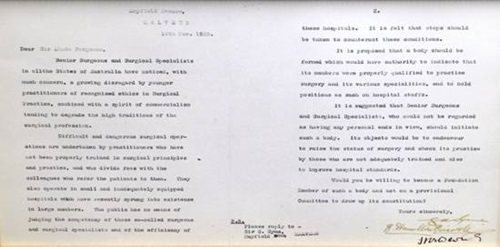Foundation Letter

The letter was written and signed by three of Melbourne's leading surgeons, Sir George Syme, R. Hamilton Russell and H.B. Devine. These men had come together from very different directions and points of view, to consider the establishment of a national body of surgeons to be of the utmost importance for the development of the profession.
Sir George Adlington Syme (1859-1929) was regarded as the senior member of the surgical fraternity in Australasia at that time. His reputation and standing within the profession was unassailable, and his support was crucial to the success of the venture. Nevertheless from 1920, when (Sir) Louis Barnett first proposed the formation of an association of surgeons, Syme had been bitterly opposed to it, supporting instead the BMA as the only legitimate medical body representative of all the interests and factions of the medical profession as a whole. Many agreed with him, including (Sir) Henry Newland, who was to become the second president of the College. In 1925 however, Syme was won over by the articulate enthusiasm of Devine, who had just returned from the USA.
Robert Hamilton Russell (1860-1933) was a leading surgeon whose specialties were the treatment of long bone fractures and inguinal hernia. He had for many years been disturbed by what he saw as inferior standards in the profession, and in 1920 had founded the Surgical Association of Melbourne, a group of general surgeons at the three teaching hospitals (the Melbourne, St Vincent's and the Alfred) who were interested in advancing surgical standards. The Association met with some fierce resistance, especially from GPs who saw it as élitist, but some of the resentment was allayed when the Association acceded to the request of the BMA that all its members should be members of the BMA. This group was to become a core of the foundation members of the College, when Hamilton Russell persuaded them to wind up the SAM in favour of the new organisation.
The real driving force behind the foundation of the College was (Sir) Hugh Berchmans Devine (1878-1959). He had supported Barnett's proposal from the start, but the catalyst came when William Mayo and Franklin Martin, founders of the American College of Surgeons, visited Australia in 1924. Their experiences fired Devine with a desire to see a similar college established in Australia. They invited him to visit them in America, and Devine took up the invitation the next year. He visited William Mayo at the Mayo Clinic in Rochester, Minnesota, and afterwards went on a cruise down the Mississippi on Mayo's houseboat. It was on this cruise that the idea finally formulated, when Mayo told Devine, "My boy, go home and found your own college and make it fit into your own Australasian conditions and circumstances". The new college would not be an arm of the BMA, or a chapter of the ACS, but an independent organisation modelled on the British collegiate tradition. Devine returned to Melbourne and set to work.
The first step towards creating a college was the Foundation Letter, sent to leading surgeons across Australia and New Zealand. Eighty-one copies were sent out, and those who responded became the Founders of the College. The letter is dated 19 November 1925. The opening sentences read,
"Senior Surgeons and Surgical Specialists in all States of Australia have noticed with much concern, a growing disregard by younger practitioners, of recognised ethics in Surgical Practice, combined with a spirit of commercialism tending to degrade the high traditions of the surgical profession.
Difficult and dangerous surgical operations are undertaken by practitioners who have not been properly trained in surgical principles and practice, and who divide fees with colleagues who refer the patients to them."
In August 1926 Professor F.P. Sandes drafted an "Exordium", giving Sir George Syme the authority to form an interim council, and to make preparations for an inaugural meeting in Dunedin in February 1927. The formation of a college, the College of Surgeons of Australasia, was ensured.
The College's archival copy of the Foundation Letter is the one sent to Sir Lindo Ferguson (1858-1948), Dean of the Otago Medical School, where the inaugural meeting of the Council was held on 5 February 1927.
